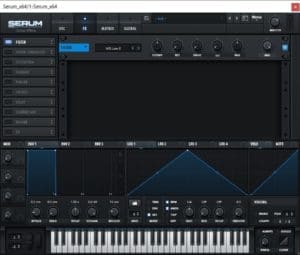

Structurally, the synth is a standard virtual analogue with three oscillators offering triangle, sawtooth, square and sine waves, plus white and pink noise, two filters switchable between series, parallel and one‑per‑oscillator configurations, and a delay section that can also double as a chorus/flanger. Twin 2 (shown in the opening screenshot) is inherently the most complex, being a fully fledged synthesizer, so this is where the FabFilter modulation system really shows what it is capable of. Now let's look at the plug‑ins themselves.

Finally, there is the MIDI source option, which allows you to use note velocity, pitch‑bend wheel, modulation wheel or any MIDI Continuous Controller as a modulation source.

There are two envelope generators: a pretty standard ADSR envelope with the addition of a threshold control, and an envelope follower with attack and release controls. The humble LFO has come a very long way indeed. If you set only two steps, one at maximum and one at minimum, and adjust the glide control, you can have either a sine or square wave (or something in between), but you can also add additional steps as you please, up to the maximum of 16, even setting the steps as random values. For instance, their X‑LFO can act both as a conventional oscillator or a step sequencer with up to 16 steps. A particularly neat touch is that the actual modulation amount sliders are modulation destinations in their own right!įabFilter have kindly provided us with all the things we would expect to be available as sources, and taken them a step further. Additionally, you can reverse the polarity of the modulation by using the ± button to the left of the slider, and switch it off using the bypass button in the top right corner of the 'slot'. To the right of this slider, a drop‑down list shows all available destinations, should you decide to change the routing. This disappears once you have chosen the destination, to be replaced with a horizontal slider showing the destination name, which controls the modulation amount.
#Serum v. fabfilter twin 2 synth Patch
To attach a source to a destination, you click and drag from the source's 'drag' button to the destination using a visual patch cable. Depending on the plug‑in, you can add up to 30 modulation sources into this area, each of which can be patched to up to eight destinations for each source. Modulation routing is handled in a section towards the bottom of each plug‑in window, which is scrollable, left to right, should you need it. So how do you offer multiple modulation options while still keeping things visually tidy? One possible answer lies in FabFilter's brilliantly titled 'What You Use Is What You See' system, which is also common to all three plug‑ins in the Creative suite. They're Giving Me ModulationsĮxtensive modulation capabilities are par for the course now, but some implementations are cryptic, at best! Some companies use a virtual patchcord system, and while this is pretty foolproof, it can also get untidy, particularly on a small plug‑in window. Given the fiery name, I imagine this was part of the design brief for Volcano. One thing I did notice early on is that the distortion/overdrive part of the filter kicks in at quite a low input level, meaning that if you are looking for clean filtering or just a little 'edge' you really do have to be careful about your input levels.

I compared them to some of my other favourite filter plug‑ins: on some sources the differences were clear, but on others I wouldn't have been able to decide between them. There's no description of the technical differences between these, but they do provide a number of variations in tone, and these are fundamentally good‑sounding filters, whatever option you choose. As well as having low‑pass, high‑pass and band‑pass types and selectable slopes of 12, 24 and 48 dB/octave, you have the choice of 11 different 'characters': FabFilter One, Smooth, Raw, Hard, Hollow, Extreme, Gentle, Tube, Metal, Easy Going and Clean. All three are heavily based upon FabFilter's, er, filters - and their highly flexible modulation architecture - but used in different ways.įabFilter are clearly proud of said filters, given that they named the company after them! And perhaps they have reason to be proud, given the extremely flexible nature of the filters in question. Timeless 2 is a tape‑delay emulation, Twin 2 is their take on a virtual analogue synth, and Volcano 2 is a powerful multi‑mode filter. The extensive modulation options available in all the FabFilter plug‑ins are augmented in Twin 2 by X‑Y pads.įabFilter's powerful plug‑in suite brings us advanced modulation possibilities, filters with multiple personalities, and plenty of overdrive.įabFilter's Creative range comprises three plug‑ins.


 0 kommentar(er)
0 kommentar(er)
